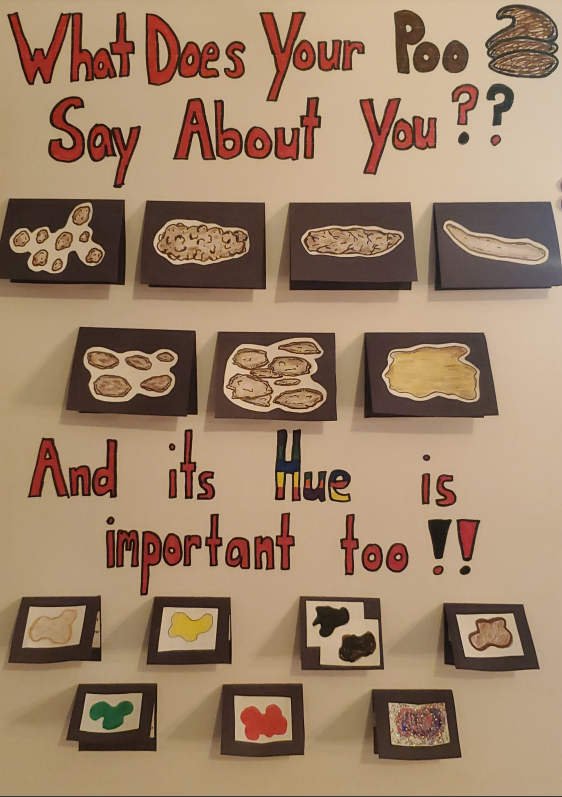



Poo, Its Hue, and Stool Tests Too
There are many words that could be used to refer to feces. Feces, stool, excrement, poo, poop, no matter what you call it, it is all the same thing. Feces is defined as semisolid waste product of digestion (Betts et al, 2022). As feces is anything that we can not digest, it can say a lot about our health. As we ingest food in our oral cavity, some absorption may begin to happen here. As the food bolus passes down our esophagus to the stomach, it mixes with gastric juices, forming chyme. Most of the absorption of what we eat occurs in the small intestines. Bacteria in the large intestines may catabolically break down some particles further, allowing for more absorption but not much, as most of what our bodies needed to absorb was done so in the small intestines. In the large intestines, some water and electrolytes are reabsorbed. Whatever is left is now officially feces. The article, The Characterization of Feces and Urine: A Review of the Literature to Inform Advanced Treatment Technology, states that “Feces are composed of water, protein, undigested fats, polysaccharides, bacterial biomass, ash, and undigested food residues” (Rose et al. 2015). The fecal matter then travels down through the large intestines, into the anal canal and is excreted through the anus.
According to HealthPartners (2024), healthy feces can be described using few characteristics. It should be cylindrical, a few inches long, semi-solid, with a brown color best depicted by the Bristol Stool Scale (Fig. 1) as type 3 or type 4. The stool in type 1 or type 2 may indicate constipation while type 6 and 7 are referred to as diarrhea.

Figure 1. The Bristol Stool Scale. Type 3 and 4 are considered healthy stools
The form our feces takes is not the only important aspect to be concerned with. Sometimes the color of feces is produced by our diets but sometimes it can be a sign of serious problems within our bodies. Brown is the normal color of fecal matter due to bilirubin waste. Black or dark colored stool could indicate bleeding, as would visibly seeing blood. Overly green stool might suggest absorption issues or bile being present in the stool. Yellow stool can also indicate absorption problems or too much fat in a person’s diet. Pasty clay or light-colored stool could signal that the body is not producing enough bile or problems with the bile duct (Zhou et al, 2023)
What can your poo say about you? To help keep a check on your overall health, including your digestive system, there are tests for your feces. These tests include gFOBT, FIT, stool cultures, and stool fat testing. gFOBT stands for guaiac-based fecal occult blood test which tests for blood in the stool using a chemical reaction. FIT means fecal immunochemical test which also tests for blood but utilizes antibodies to do so. Stool cultures help detect abnormal bacteria that are usually found in the gastrointestinal tract. Stool fat tests examine the stool for fat that is not being absorbed correctly (Canadian Cancer Center, nd). These tests can help provide you and your provider with vital information about your GI tract. Specific ailments like anal fissures, anemia, colitis, colon polyps, diverticulitis, exocrine pancreatic insufficiency, GI bleeding, hemorrhoids, infections, inflammatory bowel disease (IBD), Steatorrhea, stomach ulcers, and even colon cancer can be detected.
Literature Cited
Canadian Cancer Center. (nd). Stool Test. https://cancer.ca/en/treatments/tests-and-procedures/stool-test
Betts, J. G., Young, K. A., Wise, J. A., Johnson, E., Poe, B., Kruse, D. H., & Korol, O. (2022). Key Terms. In Anatomy and Physiology 2e. OpenStax. Retrieved from https://openstax.org/books/anatomy-and-physiology-2e/pages/23-key-terms
Rose, C., Parker, A., Jefferson, B., & Cartmell, E. (2015). The Characterization of Feces and Urine: A Review of the Literature to Inform Advanced Treatment Technology. Critical Reviews in Environmental Science and Technology, 45(17), 1827–1879. https://doi.org/10.1080/10643389.2014.1000761
Zhou, J. et al., “Stool Image Analysis for Digital Health Monitoring By Smart Toilets,” in IEEE Internet of Things Journal, vol. 10, no. 5, pp. 3720-3734, 1 March1, 2023, doi: 10.1109/JIOT.2022.3158886.
HealthPartners. (2024). HealthPartners. The healthy poop chart: What your stool says about your health. https://www.healthpartners.com/blog/healthy-poop-chart/
